| << UbuWeb |
| Aspen no. 4, item 7 |
|
|
| The Braille Trail |
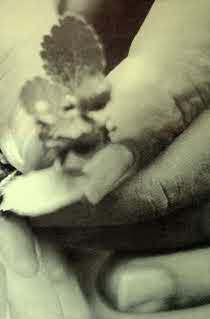
|
A self-guiding nature trail for the blind — both seeing and non-seeing — teaches us to comprehend the natural world through the purest form of communication — touch, smell, hearing — without first filtering it through sight. The Aspen Braille Trail was built high up in the Independence Pass wilderness, at 10,400 feet, by a small band of Aspenites and White River Forest Service personnel. Robert B. Lewis, scientist, idealist and prime instigator of the trail, hopes that it will serve as an experimental trail that other communities can emulate — maybe some day there'll be "a network of such trails across the country in woodlands, along streams, in the mountains and even the deserts!" We are informed at the outset that no poisonous plants, insects or reptiles inhabit this tract of land, which is to say that there are only good vibrations. Touch, taste and smell! Our sight has blinded us to many of the marvels of the natural world, since it has anesthetized our other senses. Oddly, the wonders of the natural world are even more wondrous when experienced without sight. The 23 trail markers were written by Dr. Alfred Etter, naturalist and conservationist, and our picture captions are excerpted from them. |
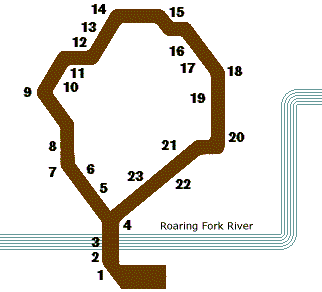
|
What would happen if there were a glad acceptance of the sensuous in all forms? — Ben Thompson |
||
|
|
|||
|
Station 1: Highway end of trail Welcome to the Roaring Fork Braille Trail! This is a cooperative effort of certain citizens of Aspen and the White River National Forest which we hope will add another dimension to the life of the blind and the life of the nation. This trail through a spruce and fir forest is designed with two ideas in mind: that people need to know the feel of nature, and that the natural world needs people who understand it and will speak out for its protection. Though you are in the midst of some of the wildest country in America, and even though you may want to walk unaccompanied, you will be safe. You will be guided by a wire. There are wires on both sides of the path, and you can reach from one wire to the other in most places. |
|
Station 2: Bridge entrance, left Nature speaks to all of us. Glorious western landscapes await discovery not only by the average tourist, but by the tourist who, deprived of sight, can sense the glories of nature by the way they feel, sound, or smell, or in new combinations of wind, humidity, and temperature. Each of you will bring back different impressions. Each of you will feel things differently, detect different odors, and hear different songs cast on the air by the birds or insects that will be your new companions. All these cannot be named or described on the Braille cards, but remember that the names of natural things are man-made, and real understanding and enjoyment do not depend on knowing a man-made name, but in sensing the variety of nature and the fascinating manner in which all the living things in an environment are tied together in a web of life. To put you completely at ease, there are no poisonous plants, insects, or reptiles. You are about to cross a thirty-foot bridge over the Roaring Fork River. Stop midway at the signal, and listen to the many stories this river has to tell. |
|
Station 3: Mid-bridge, left The Roaring Fork is a mountain stream that tumbles over rocks, rapids, and waterfalls in its quest for the sea. Its waters come from melting snows and mountain storms, from altitudes above 14,000 feet, from the rooftop of America. Sixty miles from here, at Glenwood Springs, the Roaring Fork adds its waters to the famous Colorado River. Though this splashing, noisy water may seem a hazardous place to try to make a living, the trout finds its home here, and a small bird, the water ouzel or dipper, splashes in and out of the water, sometimes walking underwater as it finds aquatic insects which support it. Sometimes you can hear it singing very joyfully like a mockingbird or wren. It sings all year round, even when the river has become a mass of ice with only a few openings at falls and rapids. |
|
Station 4: End of bridge, right As you face the wire, reach out before you and feel the foliage of the trees among which you will be walking. This one is a fir. Its needles or leaves are flat and bluntpointed, not at all prickly. Were you to be here in winter, the snow might be three feet deep, but the fir would still have its leaves and would still be making food with the help of winter sunshine. The fir is one of our favorite Christmas trees, because the needles do not fall off. In nature, when the needles do fall, they leave only a small scar on the twig. Smooth twigs help identify the fir. Probably you have already smelled the balsam aroma in the woods. Crush a leaf from the fir in your fingers and smell it. Vegetation, identified by its fragrance and feel, can serve anyone as a cheap altimeter in the mountains because different species of plants grow at different elevations. This tree is called "sub-alpine" fir, perhaps because it doesn't grow at the very tops of the mountains, but most commonly between elevations of 9 to 11,000 feet. Here you are at an altitude of 10,400 feet. |
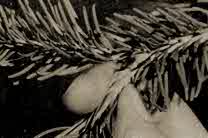
|
|
Station 5: 8 steps, right Meet the spruce in front of you. It is not so friendly as the fir. The leaves, or needles, are prickly. The stems from which the old needles have fallen are rough with little pegs, the bases of old needles. Spruce needles seem to be four-sided when you roll them in your fingers. There is a different smell, also. Spruce is less fragrant. Spruce and fir live together around the world in cool climates with abundant snow. |
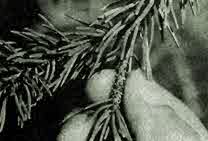
|
|
Station 6: 15 steps, right Handle the common juniper with care. It is even more prickly than the spruce. Never a tree, it spraggles about at the edges of the forest like a poorly arranged bouquet. Like the spruce and fir, it too lives the world around in snow belts. The tall, steeple-like evergreens avoid the snow by shedding it. The juniper accepts it, bending and disappearing beneath the cool cover during winter. Summer and winter, it provides a haven where small animals like squirrels and snowshoe rabbits can secrete themselves, guarded by its prickly needles. |
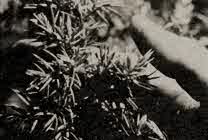
|
|
Station 7: 11 steps, left You cannot help noticing the softness of the path upon which you are walking. The spruce and fir have laid a carpet before you. They create their own environment wherever they grow, shading the soil and covering it with acid needles that decompose slowly, thus preventing most other species of plants from getting a foot, or rather, a root-hold. Kneel down and finger the forest floor. Feel the millions of needles, the deep cushion they have built. It insulates the soil, holds moisture, and covers the mountains with a blanket of protection from havy rain and freezing and thawing which soon denude a bare slope. The water of the Roaring Fork is clean and sparkling. The spruce and fir help keep it that way. |
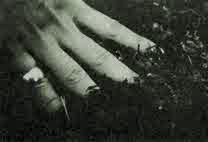
|
|
Station 8: 7 steps, left You are being watched — by a dozen eyes, at least. Squirrels and birds live in this woods. It is their home. They know every inch of it. They have their hiding places picked out in case of danger. They know where to go for their feed. Each bird gleans a different part of the tree; the chicadee searches the small twigs for insects and their eggs. The brown creeper explores the main trunk. The red or pine squirrel lives here, and at the foot of this marker, you will find a squirrel "midden." Plunge your hands into it. It is cool and flaky, made up of dismembered spruce and fir cones. Each has been handled by a hungry squirrel searching for the seeds hidden beneath the cone scales. These "middens" or "dumps" pile up beneath his favorite feeding places. He also stores cones here for the cool moisture keeps them from opening and dropping out the seeds. Cones are good indicators of humidity. When it is humid, they remain tightly sealed. |
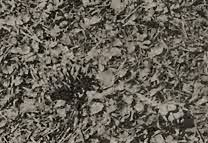
|
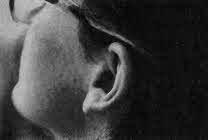
|
Station 9: 18 steps, left Is the noise you hear the wind or the river? The roar of the Roaring Fork is muted now by the many trees that separate you from the river. On windy days, the wind may make a greater noise. |
|
Station 10: 11 steps, right Kneel down and feel the remains of an old tree. It did not die a natural death. The forests along the Roaring Fork were cut during the last century, but the stumps remain. Slowly nature returns them to the soil and new trees take their place. Slowly the cycle of birth, life, death, decay, and rebirth is completed, making it possible for living things to continue living, to spread into new places and to change. Feel the top of the stump carefully with your fingers. Can you feel the concentric rings, the corrugations? Each ring is a year's growth. Count them if you have the patience. If you don't, the age of this tree is carved in Braille on the right side of the stump. (200 years, approximately) By tapping the wood of the stump, you can sense its rottenness. You can feel where the decaying wood blends into the soil around it. You may feel a little roughness on the wood. These are lichens, about which you will learn more at Station 12. |
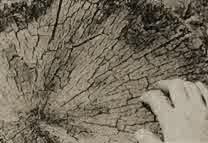
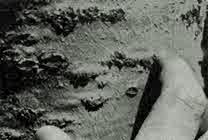
|
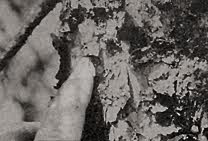
|
Station 11: 4 steps, right and left The trail narrows here to pass between two trees. Feel the trunk of the spruce on the left. It is scaly and rough. Then feel the trunk of the fir on the right. It is smooth and has little bumps on it which are often like blisters. They contain balsam oil, which is a rich, clear liquid used to mount biological specimens on microscope slides. We are more dependent on nature than we realize. |
|
Station 12: 11 steps, left A rock is an unlikely place to start a garden, yet many wild gardens begin there. Feel the rock at your feet. It is not all rock. Part of it is covered with plant growth, though it does not feel like an ordinary plant with leaves. It is only a scaly covering on the rock, but it is a garden just beginning. It is a lichen, which is not really a single plant, but a company of plants, living and working together. It takes cooperation to make a living on granite. In the beginning both plants are microscopic. One of them is a green alga that can make food from sunlight, a sprinkling of dust, and a little moisture. The other is a grey, white, or black fungus that lives off the dead cells of the alga, or the substances it produces as it grows. The two plants grow intertwined, the one providing food, the other holding moisture and providing support. It is a little like one man holding a ladder while another man climbs on it. |
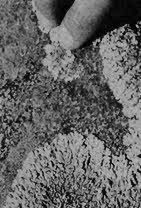
|
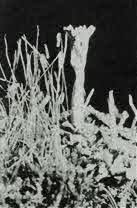
|
Station 13: 12 steps, left At the last station the lichen-covered rock was in the open, washed by rain, windblown, and sun-scorched. For nutrition it received only a little dust from the atmosphere. The lichen may have taken more than a hundred years to grow. The rock before you is protected from the wind and sun. It receives a constant rain of organic matter from the trees above, needles, tiny but continual flakings from the new twigs and old bark, pollen and fallen flowers, the excrement of insects and birds, the gnawings of ants and beetles. Slowly the rock is buried. Drought-resistant, acid-loving plants like blueberries grow on the rock. You can feel them sprouting from the thin soil. On such poor "land" they will make only tiny blueberries. |
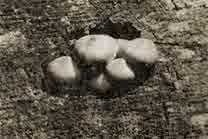
|
Station 14: 13 steps, left Perhaps you noticed a different feel in the path as you came to this station. You are standing on the moldering corpses of old trees. The wood has rotted with the help of moisture from a hillside seep and the continual digestive action of molds of many kinds which convert dead wood into living tissue, occasionally even mushrooms. These molds, or fungi, are then converted in turn by some other organism, skunk, chipmunk, bacterium, or insect, into organic waste that is passed around to be reused again, perhaps by a new generation of trees, or the plants twining among the rotting wood fibres. Smell the wet wood. No cleaner smell exists. Marvel that decay can be so clean. |
|
Station 15: 20 steps, left Here is a log to sit on. Rest and listen before you return to the noisy Roaring Fork for the sounds of the spruce and fir forest. What you hear will depend greatly upon the time of year, the time of day, and on whether it has rained. You may hear the chatterinq of the squirrel or the distant calling of an olive-sided flycatcher from the pinnacle of some tall spruce. To some it seems to say, "Come right here." Miners who have come out of the dark tunnels in the mountains may think it says, "Three Cheers!" More imaginative souls hear, "Quick, three beers!" The chicadee may call his name, or the dry nasal note of the nuthatch may be heard. Occasionally the whirring and whistling of the tiny hummingbird intrudes on the quietness of flowered places. Softest of all, audible only to the keenest ears, is the whispering flight of the hawk moth as it hovers at the mouth of a purple gentian, drinking. |
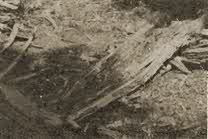
|
|
Station 16: 16 steps, right At your feet is a rug. It is cool and full of water. It is a moss, called "sphagnum" or "peat" moss. It is found round the world in bogs where the water is continually cold. It forms vast peat deposits in some areas but here it is only a thin mat that thrives because of the seepage of cold water from the mountain. Put your hands into the everwet, evercool tangle. Little wonder gardeners use this moss to hold water around the roots of plants during shipment, or in hanging baskets. It has even been used in times past for surgical dressings and "wildwood" diapers because of its absorbent and sterile character. The next few feet of trail are covered with another interesting plant. It is a little matforming plant of cold climates that is seldom seen growing anywhere but along with sphagnum moss, and where cold water seeps below the soil. It is creeping wintergreen. It really is green all winter. In the fall it is covered with bright red berries. You may get a taste of wintergreen from its leaves. |
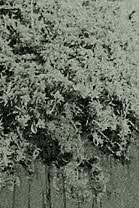
|
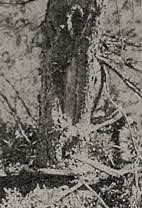
|
Station 17: 9 steps, right At the base of this tree you will find a large wound in the trunk. It was put there by a porcupine, an animal characteristic of the spruce-fir forest, but also found in the pinonpine forest of lower elevations. They subsist on the bark of trees in the winter, and sometimes cause considerable damage. At the present time, their activity is especially notable since most of their natural enemies such as the coyote and bobcat and fisher have been poisoned or trapped out of large expanses of forest country. Don't worry about encountering a porcupine. He will run, or rather, waddle, away from you. The next trail segment goes downhill toward the Roaring Fork. |
|
Station 18: 12 steps, left The descent you have just made will remind you that a river is a living, working thing. It is continually deepening its valley. Once it was running at the level of the last station. Now it is before you, at your feet. By carefully bending down you can put your hands in the cool water. You can feel stones polished and smoothed by water and washing sand. Given time the Roaring Fork will grind and roll these stones until there is nothing left except sand grains, silt, clay, and chemicals. These will be washed, in turn, into the Colorado, through the Grand Canyon, and eventually, after many delays in reservoirs created by Boulder Dam and Glen Canyon Dam, to the Gulf of California and the Pacific. Perhaps as you stand here in this valley, dwarfed beneath valley walls over 2,000 feet high, you can imagine the time it has taken to carve away all the solid rock that is no longer here. During the ice age, which now is believed to have ended some 10,000 years ago, glaciers grew and melted in this valley time and again. The tremendous weight of the grinding ice helped to speed the cutting of the valley. On the hillsides, it is possible to find grooves and scratches made by stones embedded in the glacier ice. The stones you feel here at the river's edge could tell a fantastic story if they could only speak. |
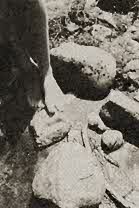
|
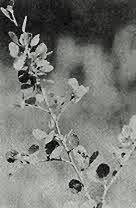
|
Station 19: 1 step, right You may sit down on a little bench of soil. It is very sandy soil, as you can feel. It was deposited here during a period of high water on the Roaring Fork. The sand is all that remains from many boulders rubbed away to nothingness by time and the river. This sandy soil offers a different kind of place for plants to grow. You can identify three kinds of bushes here. The first is willow, about waist high. You can tell it by its smooth, varnished stems. The next is bog birch, a little taller. Its stem is less smooth, almost sandy. The next, shrubby cinquefoil, is knee height. Brush your hand across the tops of its branches and feel the feathery foliage. |
|
Station 20: 15 steps, left One tree that we have not mentioned stands before you. Grasp the bushy branches that feel for all the world like a bottle-brush. This is the lodgepole pine. Because it often grows in dense stands and is tall and straight and clear of branches, it was probably a favorite building material for both Indians and mountaineers. Feel each cluster of needles. There are two in a cluster. Some pines have five. Feel along the branches for developing cones. The lodgepole grows on areas that are dry and sandy, on bare rock areas, and especially where fires have swept through. Its cones only open on the hottest and driest of sites, or when a fire comes close enough to greatly lower the humidity. |
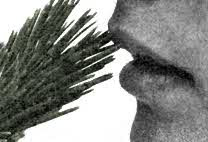
|
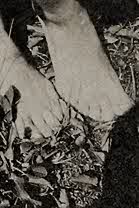
|
Station 21: 10 steps, left Jump on the soil. Note how springy it is. You are walking across the lower end of a bog, which is a wet area built up by the gradual addition of mats of moss and soil. It is a fascinating place to study plant life. Every day we walk on many wonders of nature. Grass grows between the cracks of a sidewalk, or in our yards. In this open area you walk among many interesting kinds of plants, each with its own history of living in this world. If you will kneel down facing the wire, you can run your hand over some of these creations. Possibly you can find plants with triangular, three-sided stems. These are the sedges. There is a couplet that helps us remember, "Sedges have edges, and rushes are round." But not all round stemmed plants here are rushes. There are many others. By consulting the Braille key hanging to your right, you may identify some of them. |
|
Station 22: 13 steps, right Before you is a box of cones. They are the fruiting bodies of the evergreens. They are of different sizes and shapes. Spruce cones may be two or three inches long, and cylindrical. When they are new, or wet, they are rolled up tightly and feel like a short cigar, but when they are dried out, the cone scales open outward and release the enclosed seed. Fir cones are very similar in appearance, but very few of them will be found in this woods. They commonly stay on the trees until they disintegrate. Lodgepole cones are conical. They stay on the tree for a long time, unless the red squirrel chooses to cut them off. In the three boxes on the right are the cones of spruce, fir, and lodgepole pine. In smaller boxes are the seeds of these same three trees. Can you identify them? |
|
Station 23: 15 steps, left This is the last station. The largest tree along the Braille Trail stands in front of you. Reach around it. A tree is a remarkable thing, structured to solve many problems, yet somehow attractive to human beings and to many other forms of life besides. Some trees stand alone, but most are a part of a forest, as each of us is a part of a community of living things. We are all interdependent. Nature is constantly at work in many ways and in many images to carry on the continuity of life that makes this earth unique and interesting. We have many neighbors around us who were here long before we came. In our management of the earth we must make room for them. In the scheme of things there is little doubt that they are as important as we. |
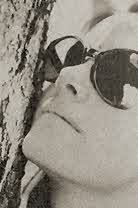
|
|
“It may very well be that in our conscious inner lives, the interplay among our senses is what constitutes the sense of touch. Perhaps touch is not just skin contact with things, but the very life of things in the mind.” “It begins to be evident that ‘touch’ is not skin but the interplay of the senses, and ‘keeping in touch’ or ‘getting in touch’ is a matter of a fruitful meeting of the senses, of sight translated into sound and sound into movement, and taste and smell. The ‘common sense’ was for many centuries held to be the peculiar human power of translating one kind of experience of one sense into all the senses, and presenting the result continuously as a unified image to the mind. In fact, this image of a unified ratio among the senses was long held to be the mark of our rationality, and may in the computer age easily become so again.” “Fragmentation by means of visual stress occurs in that isolation of moment in time, or aspect in space, that is beyond the power of touch, or hearing, or smell, or movement. By imposing unvisualizable relationships that are the result of instant speed, electric technology dethrones the visual sense and restores us to the dominion of synesthesia, and the close interinvolvement of the other senses.” The Medium is the Massage |
|
|
|
“The total environment is now the great teacher.” “We are only beginning to realize what a tiny slice of human possibilities we now educate.” “Training will be more concerned with training the senses and perceptions than with stuffing brains. Studies show a high correlation between sensory, bodily development — now largely neglected — and intelligence.” McLuhan and G. B. Leonard, “The Class of 1989.” |
|
Original format: Six-page booklet, 6 by 9 inches (one page 18 by 9 inches, accordion-folded). Photo credits: James Milmoe, Bob Chamberlain, U.S. Forest Service. Several photos are omitted here to reduce download time. |
|
|
|
|
|
|
|